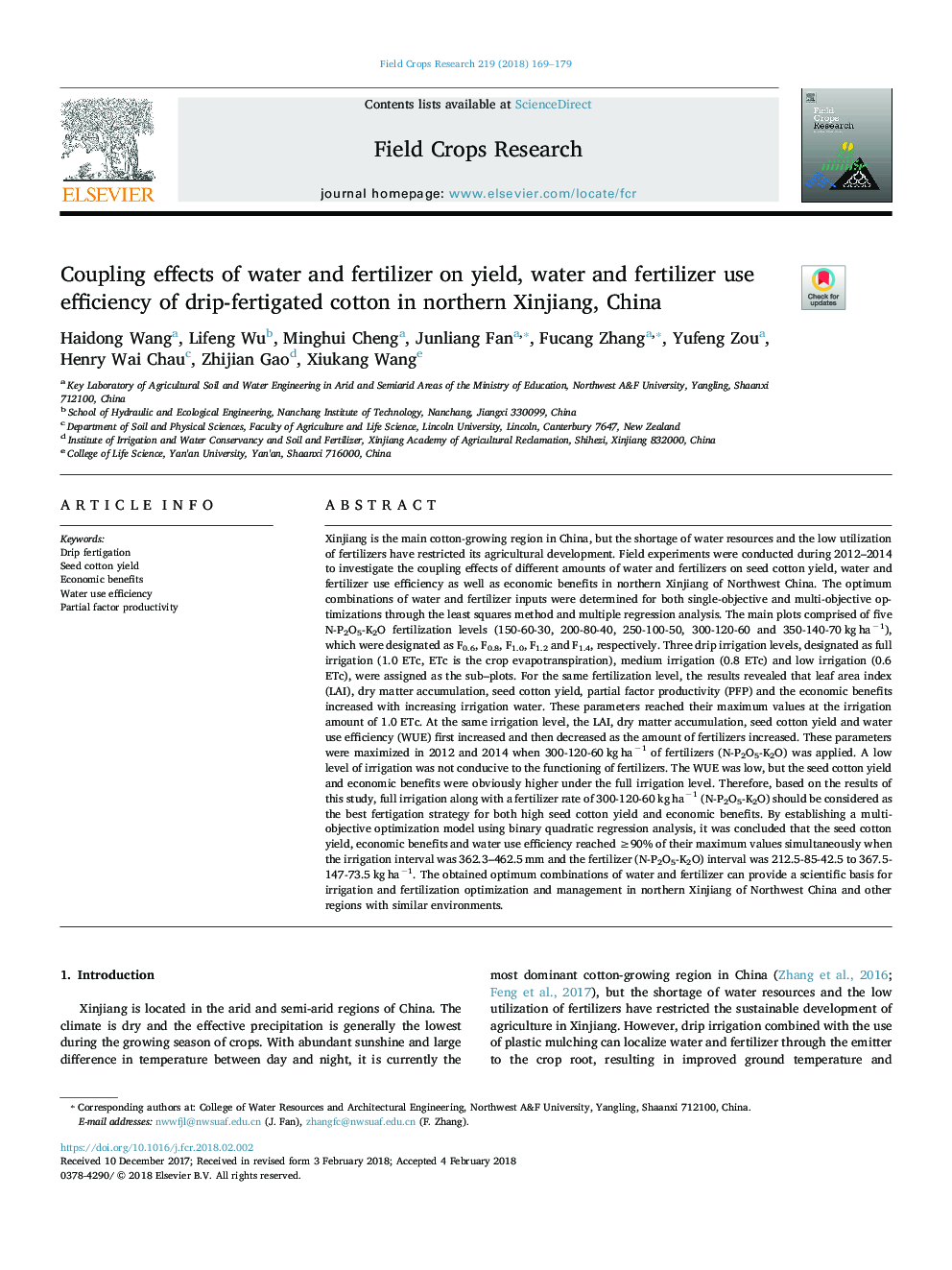| کد مقاله | کد نشریه | سال انتشار | مقاله انگلیسی | نسخه تمام متن |
|---|---|---|---|---|
| 8879321 | 1624644 | 2018 | 11 صفحه PDF | دانلود رایگان |
عنوان انگلیسی مقاله ISI
Coupling effects of water and fertilizer on yield, water and fertilizer use efficiency of drip-fertigated cotton in northern Xinjiang, China
ترجمه فارسی عنوان
اثرات اتصال آب و کود بر عملکرد، استفاده از آب و کود از پنبه قطره ای در شمال سین کیانگ،
دانلود مقاله + سفارش ترجمه
دانلود مقاله ISI انگلیسی
رایگان برای ایرانیان
کلمات کلیدی
موضوعات مرتبط
علوم زیستی و بیوفناوری
علوم کشاورزی و بیولوژیک
علوم زراعت و اصلاح نباتات
چکیده انگلیسی
Xinjiang is the main cotton-growing region in China, but the shortage of water resources and the low utilization of fertilizers have restricted its agricultural development. Field experiments were conducted during 2012-2014 to investigate the coupling effects of different amounts of water and fertilizers on seed cotton yield, water and fertilizer use efficiency as well as economic benefits in northern Xinjiang of Northwest China. The optimum combinations of water and fertilizer inputs were determined for both single-objective and multi-objective optimizations through the least squares method and multiple regression analysis. The main plots comprised of five N-P2O5-K2O fertilization levels (150-60-30, 200-80-40, 250-100-50, 300-120-60 and 350-140-70â¯kgâ¯haâ1), which were designated as F0.6, F0.8, F1.0, F1.2 and F1.4, respectively. Three drip irrigation levels, designated as full irrigation (1.0 ETc, ETc is the crop evapotranspiration), medium irrigation (0.8 ETc) and low irrigation (0.6 ETc), were assigned as the sub-plots. For the same fertilization level, the results revealed that leaf area index (LAI), dry matter accumulation, seed cotton yield, partial factor productivity (PFP) and the economic benefits increased with increasing irrigation water. These parameters reached their maximum values at the irrigation amount of 1.0 ETc. At the same irrigation level, the LAI, dry matter accumulation, seed cotton yield and water use efficiency (WUE) first increased and then decreased as the amount of fertilizers increased. These parameters were maximized in 2012 and 2014 when 300-120-60â¯kgâ¯haâ1 of fertilizers (N-P2O5-K2O) was applied. A low level of irrigation was not conducive to the functioning of fertilizers. The WUE was low, but the seed cotton yield and economic benefits were obviously higher under the full irrigation level. Therefore, based on the results of this study, full irrigation along with a fertilizer rate of 300-120-60â¯kgâ¯haâ1 (N-P2O5-K2O) should be considered as the best fertigation strategy for both high seed cotton yield and economic benefits. By establishing a multi-objective optimization model using binary quadratic regression analysis, it was concluded that the seed cotton yield, economic benefits and water use efficiency reached â¥90% of their maximum values simultaneously when the irrigation interval was 362.3-462.5â¯mm and the fertilizer (N-P2O5-K2O) interval was 212.5-85-42.5 to 367.5-147-73.5â¯kgâ¯haâ1. The obtained optimum combinations of water and fertilizer can provide a scientific basis for irrigation and fertilization optimization and management in northern Xinjiang of Northwest China and other regions with similar environments.
ناشر
Database: Elsevier - ScienceDirect (ساینس دایرکت)
Journal: Field Crops Research - Volume 219, 15 April 2018, Pages 169-179
Journal: Field Crops Research - Volume 219, 15 April 2018, Pages 169-179
نویسندگان
Haidong Wang, Lifeng Wu, Minghui Cheng, Junliang Fan, Fucang Zhang, Yufeng Zou, Henry Wai Chau, Zhijian Gao, Xiukang Wang,
